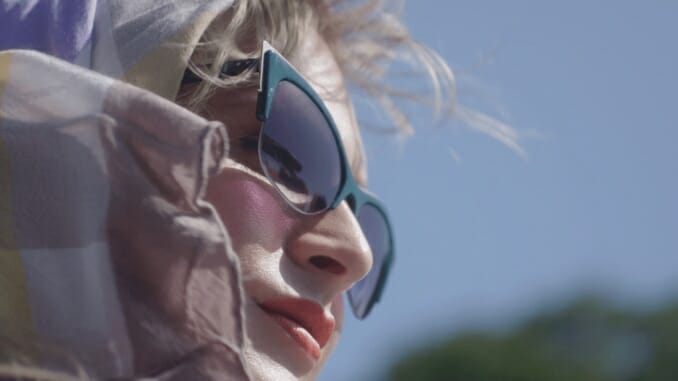The Intriguing Ideas and Rich Source Material of Framing Agnes Are Obscured by Its Own Meta

A video of Keanu Reeves has been re-circulating on the internet recently, as such videos often do. In the super short snippet, extracted from the behind-the-scenes documentary The Matrix Revisited (2001), which traces Lana and Lilly Wachowski’s formation and production of the first Matrix, the actor explains that he was given several books of philosophy to read before he could even pick up a script, among them works by Jean Baudrillard. Reeves, in his typical zealous but slightly confused fashion, boils down the French philosopher’s most referenced work, Simulacra and Simulation, to a rushed but not untrue sentence: an icon is a decay of meaning.
In Framing Agnes, a new documentary from writer-director Chase Joynt and co-writer Morgan M. Page (host of incredible trans history podcast One from the Vaults), the concept of the trans icon is explored by historian Jules Gill-Peterson and a cast of recognizable trans performers. A quasi-narrator for the film, Gill-Peterson traces some of her research in the UCLA Archives, and her knowledge of the case files of trans individuals who were involved in the UCLA Gender Clinic in the 1950-’60s. She identifies one in particular, “Agnes,” (portrayed by multi-hyphenate artist Zackary Drucker) as a folk legend who immediately spoke to her in her graduate work.
Agnes (also the subject of Joynt and sociologist Kristen Schilt’s 2019 short film of the same name) was a trans woman who lied to doctors about the spontaneous development of her breasts in order to get approved for gender confirmation surgeries normally reserved for intersex people. But we don’t learn all that much more about Agnes, the purported central figure of the documentary. Instead, Gill-Peterson investigates her own desire to place meaning on Agnes as a signifier of morality, an outlaw or paragon of transness, and poses the question: Why do we search for icons at all? What do we do when we make someone into an icon? Does it do them any favors?
Gill-Peterson is only one talking head scattered throughout Framing Agnes, which is a sort of extended thought experiment on trans visibility, invisibility and the limits of representation, among other hotly contested truths. Six other trans actors portray six individuals whose participation in the UCLA Gender Clinic was re-discovered by Joynt and Schilt through archive trawling. For our viewing pleasure, Drucker, Angelica Ross, Jen Richards, Silas Howard, Max Wolf Valerio and Stephen Ira embody their characters by reciting portions of doctor-patient transcripts, but instead of setting such recreations in a medical establishment, they’re interviewed as if they were trans curiosities of the week on talk shows of the ’60s. Playing the grating cis doctor-cum-Mike Wallace-styled talk show host is director Joynt, who took inspiration not only from the ’60s format, but from ’90s and 2000s trash TV, which delighted in exposing gender non-conforming individuals to gasps of audience and family members alike.
These short, stylized black-and-white, cathode-framed segments are interrupted throughout the documentary with brief, gauzy full-color reenactment B-roll; clips of trans celebrities dissected in front of press; and rehearsal and discussions between Joynt, Page, Schilt and the actors as themselves. The anchors of these conversations are their characters, but the topic often spirals further and further away from individuals in the case study in order for the actors to talk about their own conceptions of transness, themselves, their experience of playing their assigned cases, and even existential questions of truth and lie. At one point in the present-day talking head segments, Richards, who plays “Barbara” in the recreation segments, challenges Joynt’s line of interviewing about the very nature of truth itself. “Why are you asking that question?” We don’t learn the answer.
It’s a confusing mix that, if one were experiencing it as a piece of cinema, feels more like Revisiting the Matrix without having watched any of the completed films themselves. It’s a behind-the-scenes that shows so little of its most meticulously designed and character-driven portions that I started internally referring to it as the second disc of the documentary’s DVD set. Or maybe it’s a proof of concept for the eventual narrative or documentary feature that does dig into these character’s lives to a point that we’re familiar with the personalities their performers are referencing?
-

-

-

-

-

-

-

-

-

-

-

-

-

-

-

-

-

-

-

-

-

-

-

-

-

-

-

-

-

-

-

-

-

-

-

-

-

-

-

-








































